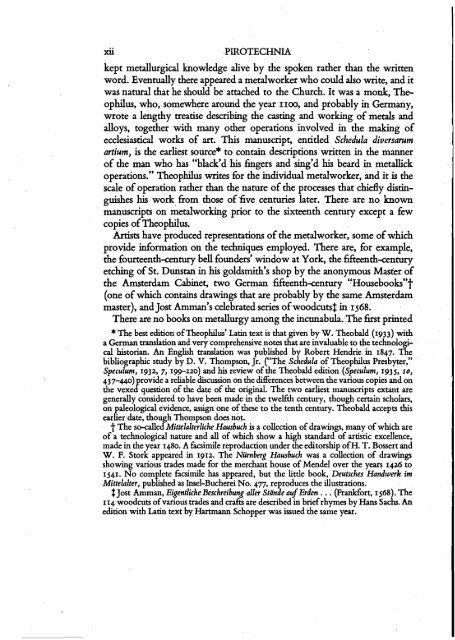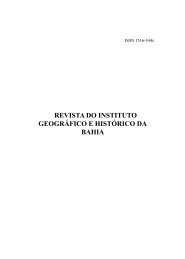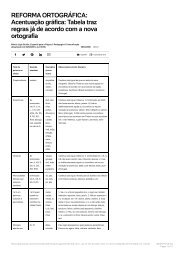Livro - Biringuccio - 09-1002-0
Artilharia os primórdios
Artilharia os primórdios
You also want an ePaper? Increase the reach of your titles
YUMPU automatically turns print PDFs into web optimized ePapers that Google loves.
kept metallurgical knowledge alive by the spoken rather than the written<br />
word. Eventually there appeared a metalworker who could also write, and it<br />
was natural that he should be attached to the Church. It was a monk, Theophilus,<br />
who, somewhere around the year 1100, and probably in Germany,<br />
wrote a lengthy treatise describing the casting and working of metals and<br />
alloys, together with many other operations involved in the making of<br />
ecclesiastical works of art. This manuscript, - entitled Schedula diversarum<br />
artium, is the earliest source* to contain descriprions written in the manner<br />
of the man who has "black'd his fingers and sing'd his beard in metallick<br />
operations." Theophilus writes for the individual metalworker, and it is the<br />
scale of operation rather than the nature of the processes that chiefly distinguishes<br />
his work fiom those of *five centuries later. There are no known<br />
manuscripts on metalworking prior to the sixteenth century except a few<br />
copies of Theophilus.<br />
Artists have produced representations of the metalworker, some of which<br />
provide information on the techniques employed. There are, for example,<br />
the fourteenthentury bell founders' window at York, the fifieenthentury<br />
etching of St. ~uns& in his goldsmith's shop by the anonymous Master if<br />
the Amsterdam Cabinet, two German fifteenthentury "Housebooks"t<br />
(one of which contains drawings that are probably by the same Amsterdam<br />
master), and Jost Amman's celebrated series of woodcuts$. in 1568.<br />
~heie are no books on metallurgy among the incunabula. The first printed<br />
* The best edition of Theophilus' Latin text is that given by W. Theobald (1933) with<br />
a German translation and very comprehensive notes that are invaluable to the technological<br />
historian. An English translation was published by Robert Hendrie in 1847. The<br />
bibliographic study by D. V. Thompson, Jr. ("The Schedula of Theophilus Presbyter,"<br />
Speculum, 1932, 7,199-220) and his review of the Theobald edition (Speculum, 1935, lo,<br />
437-440) rovide a reliable discussion on the differences between the various copies and on<br />
the vexe aFquestion of the date of the original. The two earliest manuscripts extant are<br />
generally considered to have been made in the twelfih century, though certain scholars,<br />
on aleological evidence, assign one of these to the tenth century. Theobald accepts this<br />
ear 1 'er date, thou h Thompson does not.<br />
t The so-calle d Mittelalterliche Hausbuch is a collection of drawings, many of which are<br />
of a technological nature and all of which show a h h standard of artistic excellence,<br />
made in the year 1480. A facsimile reproduction under the editorship of H. T. Bossert and<br />
W. F. Stork appeared in 1912. The Numberg Hausbuch was a collection of drawings<br />
showing various trades made for the merchant house of Mendel over the years I@ to<br />
1541. No complete facsimile has appeared, but the little book, Deutsches Handwerk im<br />
Mittelalter, published as Insel-Bucherei No. 477, reproduces the illustrations.<br />
$ Jost Amman, Eigentliche Beschreibung aller Stande auf Erdm . . . (Frankfort, 1568). The<br />
114 woodcuts of various trades and crafts are described in briefrhymes by Hans Sachs. An<br />
edition with Latin text by Harunann Schopper was issued the same year.




![[Cortar & Editat] Artigo - BOXER, C.R - Portuguese Roteiros, 1500-1700_removed](https://documents.yumpu.com/000/065/314/939/2e145b8f9d020cb1478f6bb669de4b853369b67c/6e4a3773446b6e5073444a31584c575877512f4453673d3d/79416d746a45764d6c746a757456566f3043414958413d3d.jpg?AWSAccessKeyId=AKIAICNEWSPSEKTJ5M3Q&Expires=1714406400&Signature=MMoJDDLeGDz8FYf6PivUv7jvxJc%3D)
![[Capa & Editar] Artigo - BARROS, Sigrid Porto de - A](https://documents.yumpu.com/000/063/816/786/af709ce29d1c721e5f74c145faeb760c1556c101/714f48715a616a2f324a556f537178394e6b4b4f54413d3d/45394b5a5354347734556b4a575634636c39565037413d3d.jpg?AWSAccessKeyId=AKIAICNEWSPSEKTJ5M3Q&Expires=1714406400&Signature=%2BjSFp6BSVgpiHt%2BCsLdoSnCyJis%3D)


